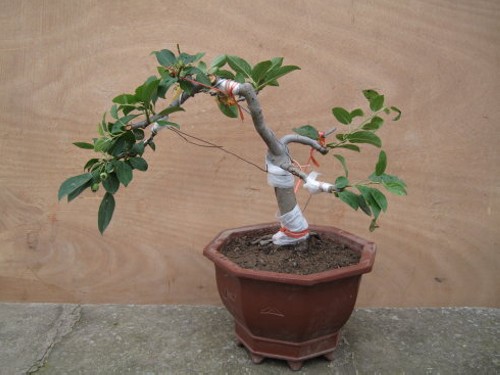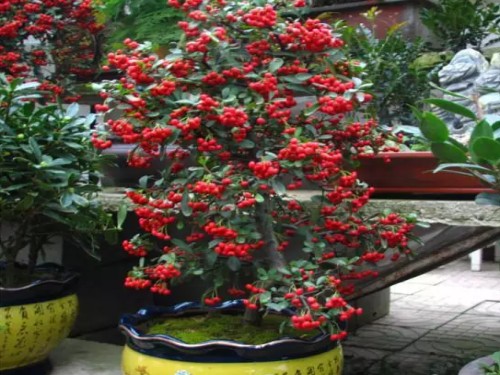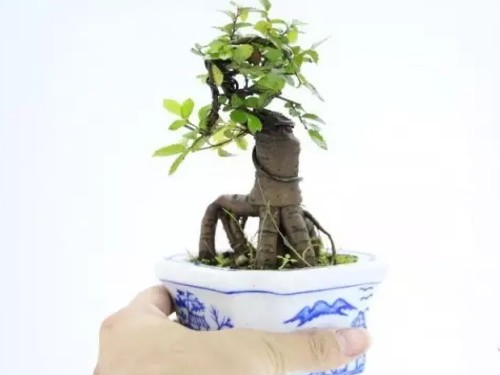What if the bonsai leaves of winter red fruit turn yellow? How to raise winter red fruit?
Donghong fruit is easy to flower, high fruit setting rate, red fruit, fruit hanging period can be extended to the next year's flowering and long leaves sometimes do not fall off, is an excellent variety of fruit bonsai, deeply loved by the people. But in the process of cultivation, the leaves often appear yellowing and shedding due to the limitation of pot capacity and other influences. The main reasons for its yellowing are as follows:
1. Light discomfort
Strong light irradiation, easy to appear branches and leaves yellow, wilting, tip coke, and weak light irradiation, easy to lead to excessive growth of branches, poor fruit coloring, small leaves and yellow off. Therefore, when winter red fruit enters the viewing period, it should be placed close to the windowsill indoors so that it is in bright scattered light.

2. Temperature discomfort
Winter red fruit likes light but can not be too strong, especially in hot summer, strong direct sunlight, will make the air dry, pot soil temperature rise, resulting in damage to the root system, reduce enzyme activity, resulting in red leaves, leaf tips dry, yellowing litter. For this reason, in summer, it should be placed in a ventilated place, and often spray water around the tree to reduce the air temperature.
3. Too much watering
(1) Due to excessive watering of the pot soil, water accumulation is caused, so that the pot soil is deprived of oxygen, some fibrous roots suffocate and rot, and lose the ability to absorb water and nutrients. At the same time, respiration increases bicarbonate ions, which in turn affects the absorption of iron, causing the top tender leaves to be pale yellow and wilting, and the old leaves are gradually dark yellow. Discovered this phenomenon, should immediately plant with soil ball off the pot, put in a cool and ventilated place, often spray water to the leaves, do not spray water to the roots, so that its water evaporation as soon as possible. After the plants return to normal, put them into the pot.
(2) If the pot soil is not watered for a long time or the watering is not thorough, the top center of the winter red fruit and the leaf color of the new leaf are normal, but the old leaves in the lower part gradually dry up and yellow, curl and fall off, the fruit shrinks and the fruit drops seriously. In this case, do not immediately pour water into the pot soil, put it in the semi-shade first, spray water on the leaves first, and when the leaves do not wilt, use the dipping pot method to slowly soak the pot soil with water. If watering is used, due to the loose cracks in the pot wall, water is easy to drain from the cracks, resulting in water impermeability. In short, we should follow the principle of "not dry, not poured, poured thoroughly".
(3) Donghongguo likes slightly acidic soil. Because the water in the north is alkaline, long-term watering leads to the soil becoming alkalized gradually, so that the plants cannot absorb iron elements. In the cultivation process, 1 portion of ferrous sulfate, 10 portions of bean cake fertilizer and 200 portions of water are often used to change the alkaline soil after decomposition.
4. Excessive fertilization
(1) excessive fertilization, too thick and cause yellow leaves. The new leaves are thick and glossy, dark green, but the back of the leaves is wrinkled and raised, the leaves are not stretched, and the old leaves in the lower part of the plant gradually turn yellow and fall off. At this time, winter red fruit should be placed in shade, the flowerpot soaked in water to dilute fertilizer, two hours later, the plant with soil ball off the pot, dry water. If necessary, remove old leaves and remove some old soil for new soil.
(2) Donghong fruit grows strongly. It needs to change pots once every 2~3 years. Otherwise, it is easy to form root pads, resulting in poor air permeability of pot soil, difficulty in root water absorption and fertilizer absorption, thin branches, long internodes, thin and tender yellow leaves, color difference of flowers, and difficulty in fruit setting. For this reason, in dormant period, should combine pruning root, carry on change basin change soil.
(3) During the cultivation process, due to the application of undecomposed organic fertilizer, the fertilizer is fermented in the basin, causing the root system to burn or poison, the root system to turn black and rot, the leaves to wither and turn yellow, and even the whole plant to die. Therefore, organic fertilizer must be decomposed when applied. Iron deficiency chlorosis is usually deeper, yellow-green color boundary is often obvious, generally do not appear brown spots, and manganese deficiency chlorosis is lighter, and often brown spots or brown strands.
How to raise winter red fruit bonsai?
1. Basin soil
The pot soil is required to be renewed once every 2 years. The pot soil ratio can be mixed with 35% of rotten leaf soil and garden soil, 20% of coarse sand and 10% of decomposed animal dung as base fertilizer. When changing the soil, first turn the bamboo along the inner wall for 1 circle, then turn the basin upside down, hold the soil ball with one hand, and make it pour out along the drain. Then use a sharp edge to cut off about 1/3 of the old soil and old roots on the periphery of the soil mass, and then re-pot, and irrigate thoroughly.
2. Watering
Watering should master the principle of "see dry see wet", that is, the pot soil is slightly dry and then watered, watering must be poured thoroughly. However, in the critical period of flower bud differentiation (when the physiological differentiation period begins in June), the winter red fruit potted plant is treated with drought for a period of time, that is, watering every time when the top of the new shoot wilts, so that watering is controlled for 6-8 times. Drought stress could inhibit the vegetative growth of shoots and promote flower bud differentiation.
3. Fertilization
The use of fertilizer, to master the principle of thin fertilizer application. To give full play to the efficacy of fertilizer, attention must be paid to the combination of organic fertilizer and inorganic fertilizer, late-effect fertilizer and quick-acting fertilizer, macroelements and trace elements in fertilizer selection. Fertilization methods pay attention to the combination of soil dressing and foliar spraying. Apply more nitrogen fertilizer before flowering, and irrigate 5-6 times with decomposed cake fertilizer water of 1:100-150 times, with an interval of about 10 days each time. After the first ten days of June, Donghong fruit enters flower bud differentiation stage, so it is necessary to control nitrogen fertilizer, increase phosphorus and potassium fertilizer to promote flower bud differentiation, and cooperate with foliar fertilizer when necessary. 7-9 During the month should strictly control or even stop the application of fertilizer with excessive nitrogen content, to prevent the occurrence of a large number of autumn shoots.
4. Winter
After frost, winter red fruit should be moved into cold room or room, the environment is required to be relatively dry, the temperature is controlled at 0~12℃, if placed in a high temperature and humid environment, the fruit is easy to rot. Winter red fruit after winter, before the flower bud begins to expand and germinate, should be moved to the outdoor contact with natural temperature, so that the development of flower buds and natural fruit trees synchronous, easy to use natural fruit trees flowers to pollinate, in order to ensure the fruit set of winter red fruit pot trees.
Time: 2019-06-01 Click:
- Prev

Maintenance method of bonsai of winter red fruit
Winter red fruit alias pear blossom begonia, also known as longevity fruit, Christmas red fruit, for Rosaceae, apple genus, deciduous shrubs or small trees, is the production of flowers, fruit bonsai in a good product. As a result, the fruit is as blue as Jasper in summer, red as red in autumn, and red as purple as red pearl in winter.
- Next

How to maintain the bonsai of hammer elm
The dried elm is slightly curved, the bark is mottled and elegant, the twigs are graceful, and the autumn leaves turn red. It is a good ornamental tree and factory greening, greening tree species on all sides, often planted alone into a scene, suitable for planting near the pond and pavilions, but also between mountains and rocks, but there are more diseases and insect pests. It has strong sprouting power and is a good material for making bonsai. The tree is graceful
Related
- Fuxing push coffee new agricultural production and marketing class: lack of small-scale processing plants
- Jujube rice field leisure farm deep ploughing Yilan for five years to create a space for organic food and play
- Nongyu Farm-A trial of organic papaya for brave women with advanced technology
- Four points for attention in the prevention and control of diseases and insect pests of edible fungi
- How to add nutrient solution to Edible Fungi
- Is there any good way to control edible fungus mites?
- Open Inoculation Technology of Edible Fungi
- Is there any clever way to use fertilizer for edible fungus in winter?
- What agents are used to kill the pathogens of edible fungi in the mushroom shed?
- Rapid drying of Edible Fungi

